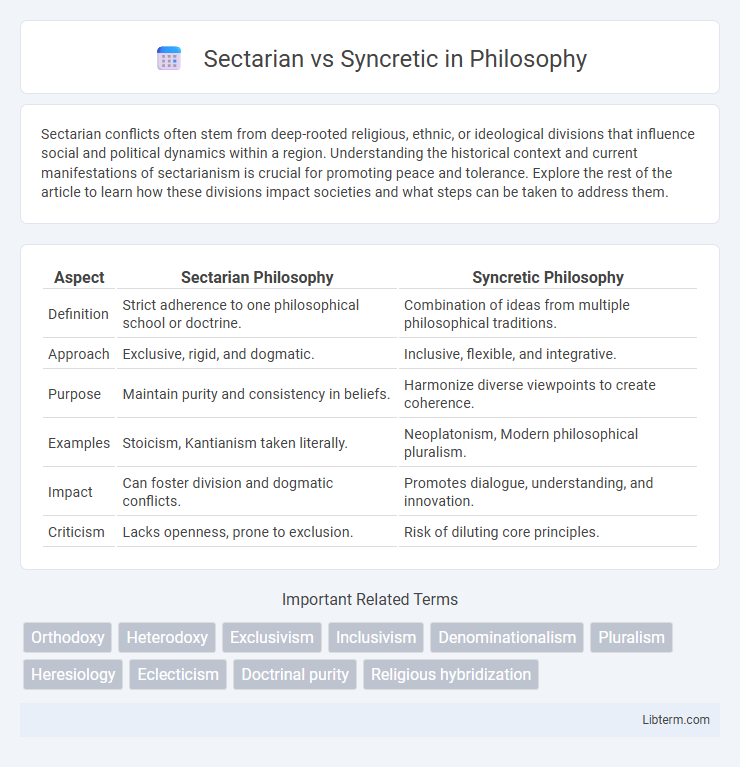Sectarian conflicts often stem from deep-rooted religious, ethnic, or ideological divisions that influence social and political dynamics within a region. Understanding the historical context and current manifestations of sectarianism is crucial for promoting peace and tolerance. Explore the rest of the article to learn how these divisions impact societies and what steps can be taken to address them.
Table of Comparison
| Aspect | Sectarian Philosophy | Syncretic Philosophy |
|---|---|---|
| Definition | Strict adherence to one philosophical school or doctrine. | Combination of ideas from multiple philosophical traditions. |
| Approach | Exclusive, rigid, and dogmatic. | Inclusive, flexible, and integrative. |
| Purpose | Maintain purity and consistency in beliefs. | Harmonize diverse viewpoints to create coherence. |
| Examples | Stoicism, Kantianism taken literally. | Neoplatonism, Modern philosophical pluralism. |
| Impact | Can foster division and dogmatic conflicts. | Promotes dialogue, understanding, and innovation. |
| Criticism | Lacks openness, prone to exclusion. | Risk of diluting core principles. |
Understanding Sectarianism: Definition and Origins
Sectarianism refers to divisions and conflicts within a larger group based on differences in religious, ethnic, or ideological beliefs, often leading to social exclusion and violence. It originates from historical disputes and power struggles where distinct sects emerge with rigid boundaries to protect their identity and interests. Understanding sectarianism involves analyzing its deeply rooted causes in cultural, political, and theological contexts that perpetuate division and resistance to integration.
What is Syncretism? Meaning and Key Concepts
Syncretism is the blending of different religious, cultural, or philosophical beliefs into a unified system, often creating new traditions or practices. It involves the integration of diverse rituals, symbols, and doctrines, facilitating coexistence and adaptation across various communities. Syncretic approaches promote inclusivity and cultural exchange, contrasting with sectarianism, which emphasizes strict adherence to specific doctrines and often results in exclusivity.
Historical Roots of Sectarianism and Syncretism
Sectarianism historically emerges from rigid adherence to specific religious doctrines, often rooted in events like the Protestant Reformation or Sunni-Shia split, reinforcing identity boundaries and conflict. Syncretism develops through cultural exchanges such as the Hellenistic period or the spread of Buddhism, blending diverse religious beliefs into new, cohesive systems. The historical roots of sectarianism emphasize division and exclusivity, whereas syncretism highlights integration and adaptation.
Core Differences Between Sectarian and Syncretic Approaches
Sectarian approaches emphasize strict adherence to specific religious doctrines and practices, often fostering exclusivity and clear boundaries between belief systems. Syncretic approaches blend elements from multiple religious traditions, creating inclusive and adaptive interpretations that bridge diverse spiritual perspectives. The core difference lies in sectarianism's maintenance of separation versus syncretism's integration of differing beliefs.
Examples of Sectarian Movements in Religion and Society
Sectarian movements often emerge within religious contexts where distinct groups, such as the Sunni and Shia branches of Islam or the Protestant and Catholic factions in Christianity, emphasize exclusive doctrinal beliefs and practices. These divisions can also manifest in society, as seen in the Sunni-Shia conflicts in the Middle East or the sectarian tensions in Northern Ireland between Protestants and Catholics. Understanding these examples highlights how sectarianism prioritizes identity and rigid boundaries, often resulting in social and political consequences.
Syncretism in Practice: Cultural and Religious Blending
Syncretism in practice involves the blending of cultural and religious traditions to create new, hybrid belief systems that reflect diverse influences and local contexts. Examples include the fusion of Indigenous rituals with Christian practices in Latin America, and the integration of Buddhist and Taoist elements in East Asian spiritual customs. This blending fosters social cohesion and enriches cultural identities by accommodating multiple worldviews within a single framework.
Advantages and Challenges of Sectarian Perspectives
Sectarian perspectives offer advantages such as a strong sense of identity and community cohesion, fostering loyalty and clear boundaries within groups. However, these perspectives face challenges including potential exclusion of outsiders, limited adaptability, and increased risk of conflict due to rigid belief systems. Balancing sectarian commitment with openness remains a critical hurdle for sustainable social harmony.
Benefits and Criticisms of Syncretic Approaches
Syncretic approaches in religion and culture promote harmony by blending diverse beliefs, fostering inclusivity and mutual understanding among different groups. These methods encourage cultural exchange and reduce sectarian conflict by emphasizing common values and shared spiritual experiences. Critics argue syncretism can dilute distinct traditions, leading to loss of authentic practices and potential misinterpretation of core doctrines.
Sectarian vs Syncretic: Impact on Social Harmony
Sectarianism often fosters division by promoting exclusive group identities, leading to social fragmentation and conflict within diverse communities. Syncretic approaches blend beliefs and practices from multiple traditions, encouraging mutual understanding and coexistence, which enhances social harmony. The contrast between sectarian rigidity and syncretic flexibility significantly influences the stability and cohesion of multicultural societies.
Future Trends: Sectarianism, Syncretism, and Globalization
Future trends indicate sectarianism may intensify due to rising identity politics and geopolitical conflicts, reinforcing rigid religious boundaries. Syncretism is gaining momentum as globalization fosters cross-cultural exchanges, encouraging hybrid religious practices and new belief systems. The interplay of digital communication and migration accelerates both phenomena, shaping complex religious landscapes worldwide.
Sectarian Infographic

 libterm.com
libterm.com